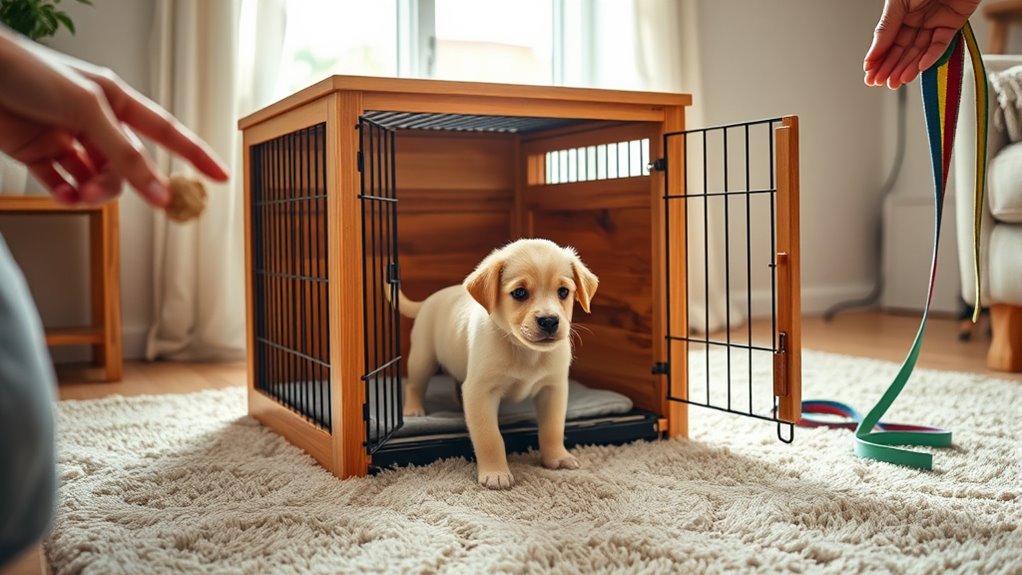To crate train your dog step by step, first choose a properly sized crate that’s comfortable and inviting. Introduce the crate gradually using treats, toys, and praise to create positive associations, then slowly increase the time your dog spends inside. Establish a consistent routine for potty breaks and crate time, rewarding good behavior and minimizing accidents. Be patient and gentle throughout the process. If you want to learn more strategies for successful crate training, keep exploring these helpful tips.
Key Takeaways
- Introduce the crate gradually using treats, toys, and praise to create positive associations.
- Choose a properly sized crate that allows the dog to stand, turn around, and lie down comfortably.
- Establish a consistent routine for feeding, potty breaks, and crate time to reinforce good habits.
- Use positive reinforcement to praise the dog when they eliminate outside and avoid punishing accidents.
- Gradually increase crate time as the dog becomes more reliable, ensuring the space remains a safe and comfortable retreat.

Crate training is an effective way to help your dog feel secure and learn good habits. When starting, it’s vital to understand housebreaking techniques that will make the process smoother for both of you. A crate can become a den-like space your dog naturally seeks out, which can speed up housebreaking and reduce accidents. To begin, you’ll want to focus on selecting the right crate, as crate selection tips can greatly influence your dog’s comfort and your training success. Look for a crate that’s appropriately sized—your dog should be able to stand up, turn around, and lie down comfortably without feeling cramped. A crate that’s too large might encourage your dog to eliminate in one corner, defeating the purpose of housebreaking, while one that’s too small can cause discomfort and stress.
Once you’ve chosen the perfect crate, introduce it gradually. Encourage your dog to explore the crate on their own by placing treats, toys, or a cozy blanket inside. Avoid forcing your dog into the crate; instead, let them enter voluntarily. When they do, praise and reward them to establish a positive association. Keep the door open initially so they can come and go freely. As your dog gets comfortable, start closing the door for short periods while you’re nearby, gradually increasing the duration as they become more accustomed to being inside. This step-by-step approach helps your dog associate the crate with safety rather than punishment.
Introduce the crate gradually with treats and praise to build positive associations.
During crate training, consistency is key. Stick to a regular schedule for meals, potty breaks, and crate time. This predictability helps your dog understand what to expect and reduces anxiety. Use housebreaking techniques like taking your dog outside immediately after waking, after eating, and before bedtime. When your dog eliminates outside, praise and reward them enthusiastically. If they have an accident inside, calmly clean it up without fuss, and avoid punishing your dog. Instead, focus on reinforcement of good behavior. Incorporating positive reinforcement techniques can significantly improve your training outcomes.
Always make the crate a positive space. Never use it as a punishment, and avoid leaving your dog in it for long periods. Short, frequent crate sessions are most effective, especially when your dog is still learning. As they grow more comfortable and reliable, you can extend the time they spend inside. Remember, patience and consistency are vital. Over time, your dog will view the crate as a safe retreat, making housebreaking more straightforward and providing both of you with peace of mind.
Frequently Asked Questions
How Long Should a Puppy Stay in the Crate Daily?
You should limit puppy confinement to about 3-4 hours at a time during the day, gradually increasing as they grow. Remember, crate duration depends on your puppy’s age, with younger pups needing more frequent breaks. Keep crate sessions short and positive, ensuring they have enough time outside for play, potty, and socialization. Never leave your puppy in the crate for extended periods, as it can cause stress and hinder development.
Can Crate Training Help With Separation Anxiety?
Yes, crate training can help with separation anxiety by providing your dog with a safe, comfortable space that promotes crate comfort. When you introduce the crate gradually and positively, your dog begins to associate it with security, which can reduce anxiety when you’re away. Consistent crate use, combined with gentle reassurance, helps your dog feel more relaxed, easing separation stress and encouraging calm behavior in your absence.
What Size Crate Is Appropriate for a Growing Dog?
You should choose a crate size that allows your growing dog to stand, turn around, and lie down comfortably without feeling cramped. As your dog grows, you’ll need to upgrade to a larger crate to guarantee crate comfort and prevent stress. A properly sized crate helps your dog feel secure, making crate training easier and more effective. Always select a crate that adapts to your dog’s changing size for the best results.
Is Crate Training Suitable for All Dog Breeds?
Crate training can work for most dog breeds, but breed compatibility impacts how smoothly it goes. Some breeds may face training challenges due to their energy levels or independence, and others may feel more comfortable in a crate. You should consider your dog’s temperament and size. With patience and proper approach, you can successfully crate train many breeds, but recognize that some might need extra support or alternative methods.
How Do I Introduce My Dog to the Crate Gradually?
Think of introducing your dog to the crate as opening a welcoming door. Start by placing your dog inside with their favorite toy, ensuring crate comfort. Gradually introduce short stays, praising and rewarding them each time. Keep the experience positive and calm. Over time, extend the duration of crate time, always following a gradual introduction approach. This helps your dog see the crate as a safe, cozy space, not a punishment.
Conclusion
By following these steps, you’re well on your way to successfully crate training your dog. Patience and consistency are key—aren’t they? Remember, your crate is a safe haven, not a punishment. With time, your pup will see it as a comforting space. So, are you ready to build that trusting relationship and give your furry friend the secure environment they need to thrive? Keep at it, and you’ll both reap the rewards!










